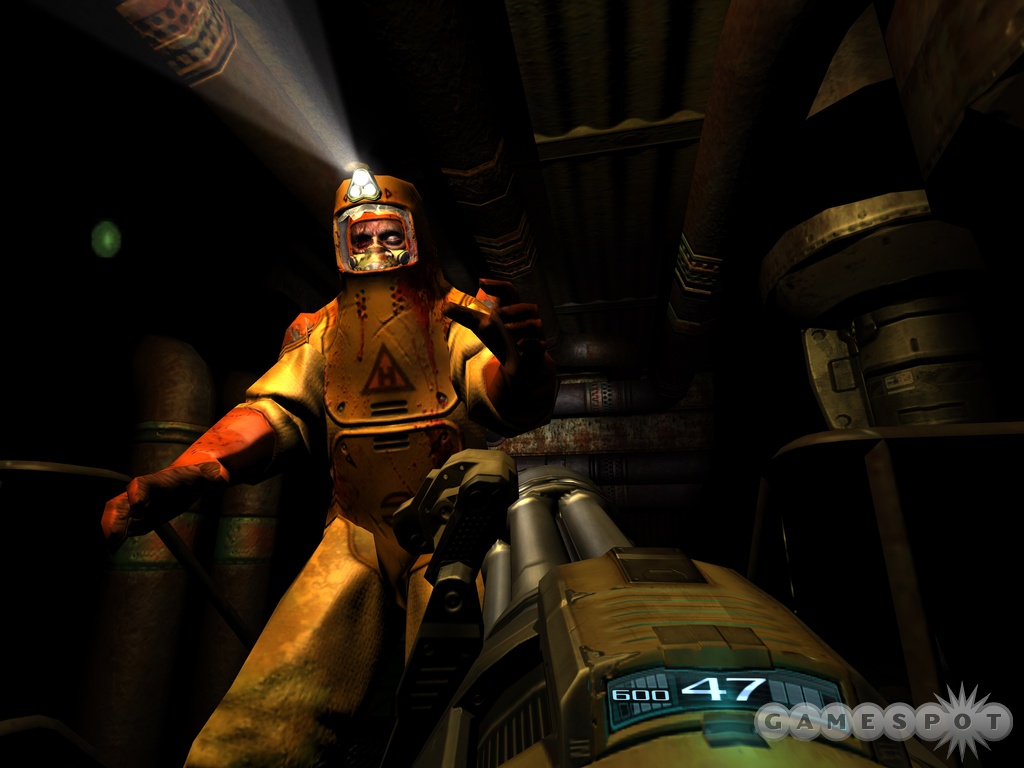

New enemies are various variations of this sort of design, having their own tricks, attacks, and rhythms. The early introduction of the imps will quickly inform you, as their fireballs are now lobbed as small explosives and a new leaping attack that the game likes them to use right when you encounter one by opening a door. The monster roster is almost entirely from the original game, with a touch of Doom II demons mixed in, all of them changed up in small ways to give them a different rhythm to match the new horror action focus.

Even flying enemies often come at you in compact hallways. Doom 3 is very horizontal in its design, with only a scant few bits of verticality heavy moments. There’s a lot more original game DNA here than you’d expect. It really gets fun when Betruger starts talking to you constantly in the late game, his actor Philip Lewis Clarke just having a ball hamming it up. You have to get through the gore splattered base and figure out what’s happening, why, and what to do about it, with various twists and turns. After being tasked with bringing back a scientist who broke into an abandoned comm section, you find out he’s trying to send a warning about Betruger’s teleportation experiments that lead to them finding and screwing with Hell, which, within the next second, has decided to screw back. Betruger, who is very clearly the villain, your commanding Sergeant over the radio, and a third party group from the UAC (United Aerospace Corporation, the governing power of the Doom franchise) traveling through the base on their own independent investigation when things go to Hell – literally. The wrinkle this time is that we have a main scientist named Dr. It’s a more fleshed out set up of the original game, with a space marine arriving on Mars for military service. Even some of Id’s big shots were iffy on even doing this project, mainly Kevin Cloud and Adrian Carmack, and the rest of the studio had to fight for it. It was Id’s best seller at the time, but not everyone dug what it was doing. As the game was previewed, hype built up fast due to the beautiful shadow work of Carmack’s new Id Tech 4 engine, and the game went over well at release. It would be a reboot point for Doom as a series, even though it was called Doom 3. It feels like Willits and team went back to the Doom bible and decided to try Tom Hall’s idea of a narrative based horror game, mixing it with traditional FPS gameplay filtered through the modern Half-Life inspired trends. This is probably the single most contentious entry in the franchise, mainly because it was a new take on Doom that never really got fans to latch to it down the line. We’ll see more of Willits creative stamp with RAGE later, but for now, we’ll be looking at the first project he had a lead role on. He ended up in a major role at the company and stayed there longer than any of the other old guard, only leaving in 2019 to join Saber Interactive, where he now heads former competitor 3D Realms after Saber purchased them. While Id credits were still kind of a mess, the creative lead this time was said to be by many to be Tim Willits, who joined the company towards the end of their DOOM projects and into their big Quake change over, where he worked mainly as a mapper.
#Doom 3 betruger series
The series would finally return in 2004 to push Id’s newest engine, taking into account major technological improvements and adding in the “Carmack’s Reverse” shadow tech that would make this game unique. Perhaps DOOM was over-saturated in the late 1990s, as id moved away from the series to focused on Quake, while receiving competition from games like Duke Nukem 3D and Unreal, fighting them off with personality and rival deathmatching goodness. Note: Screens, unless stated otherwise, were taken with the fan made source port dhewm3, which mainly gives support for higher resolutions while keeping the original look intact


 0 kommentar(er)
0 kommentar(er)
